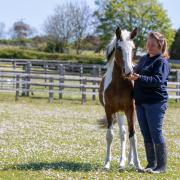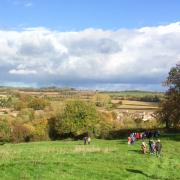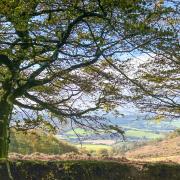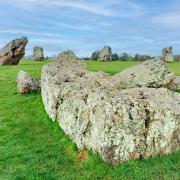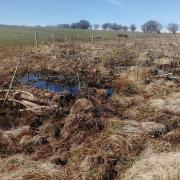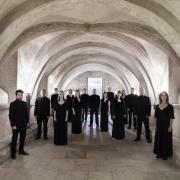An excavation at a mysterious medieval church near Radstock has uncovered two 18th-century adult skeletons (one buried a metre underneath the central aisle), an 18th-century child skeleton, medieval pottery and an entrance to an unknown crypt.
The Hidden Holcombe project, run by the Churches Conservation Trust (CCT) with Wessex Archaeology, has been set up to discover more about St Andrew’s Church and its surroundings.
The archaeologists, including Phil Harding from TV’s Time Team, Dr Neil Rushton from CCT and osteoarchaeologist Jackie McKinley, use cutting-edge techniques such as laser-scanning the building and surrounding landscape from a drone plane to highlight any unusual or unexpected features.
The building is situated in an isolated rural position a mile from Holcombe village and archaeologists hope their results will shed light on whether the church, which dates back to 1100, could originally have been part of a medieval village that has since disappeared.
Local enthusiasts were invited to help survey the churchyard and process the artefacts that were found during the dig.
The church at Holcombe is one no longer used for regular worship and which has been saved by the Churches Conservation Trust. A national charity protecting historic churches at risk, CCT has saved more than 340 beautiful buildings; these attract almost two million visitors a year.
All CCT’s churches remain consecrated and are used for occasional services.
CCT works with local people to bring historic churches back into the heart of the community as a social, tourism, educational or cultural resource and the charity’s care of Grade I and II* buildings has given it an international reputation in heritage conservation and regeneration.
Known previously as the Redundant Churches Fund, CCT takes on buildings of high architectural or historical merit that are no longer needed for worship and no other use can be found for them.
The charity looks after 18 churches in Somerset and the dig at St Andrew’s is part of CCT’s Hidden Somerset project.
The final phase of the investigations at Holcombe takes place this month with the launch of a new Young Archaeologists’ Club for Somerset in collaboration with Somerset County Council, Somerset Archaeology and Natural History Society and the Council for British Archaeology.
Hidden Somerset will then be rolled out to other churches across the county.
One of those on the list is Holy Saviour’s in Puxton near Weston-super-Mare, where I catch up with Dr Neil Rushton who is CCT’s Conservation Project Manager for the west region.
This wonderful little medieval church, with its 14th-century leaning tower, has a rustic interior featuring some oak box pews and a Jacobean pulpit.
Dendrochronology, or tree-ring dating, has revealed that some of the pews date back to about 1420, explains Neil.
“There aren’t many medieval pews left and for some reason Somerset has more than any other county.
“Puxton is a very interesting church because there is an abandoned settlement to the south of the church that has been shown from aerial photography carried out before.
“Again, St James’ Church at Cameley, near Temple Cloud, and St Nicholas’ Church at Brockley near Banwell, probably have deserted medieval villages close by.
“Hidden Somerset is a long-term project with the expectation to explore all the Somerset churches, but we have prioritised Puxton, Brockley and Cameley because they are really interesting churches with interesting landscapes around them.”
Hidden Somerset will involve local history societies looking into historical aspects of the churches and the communities around them; there is also a training and educational component.
“We want to get local people involved, students and anyone who is interested in finding out how archaeological surveys work,” says Neil.
The late Professor Mick Aston, known for his work with Channel 4’s Time Team, was an advisor to the project. The data on Holcombe is currently being processed by CCT and Wessex Archaeology, prior to publicising the results in magazines and websites.
When the other churches are investigated, the archaeologists hope to carry out more aerial scans. The innovative laser scanning drone planes cover an area of 10sqkm around the church, picking up evidence of archaeological features that can’t be seen from ground level. This large scale ground survey helps rebuild the medieval landscape around the building.
Neil explains: “If we do a 10km square laser scan around each church we will have good coverage of Somerset and a good landscape interpretation of the county.”
The churches cared for by CCT are often used as community spaces – for exhibitions and concerts.
“They are great buildings, so why wouldn’t you use them,” says Neil, who adds that the churches found countrywide make the English landscape different from anywhere else.
“Somerset certainly does have some of the finest churches, especially church towers. A lot of these were rebuilt in the 15th century when sheep farming brought wealth to Somerset. They are perpendicular gothic towers; some people might call them wool towers. The big sheep farming places such as Somerset, Norfolk and Suffolk, benefited on the back of wool.”
It’s hoped that young people will be inspired by the completion of the church survey at Holcombe in the summer and join the new group being established for them.
“There is a Bristol Young Archaeologist Club but there’s not one in Somerset so we are hoping to fill that gap by starting it off at Holcombe,” says Neil.
“I’ve been an archaeologist since 1992 and that was the same year that Time Team started. This revolutionised the interest in archaeology and history and heritage.
“I think that it’s incredibly important to get younger people interested – not just for archaeology but for heritage in general, because if you don’t get those children involved now, who’s going to care about it in the future?” n






